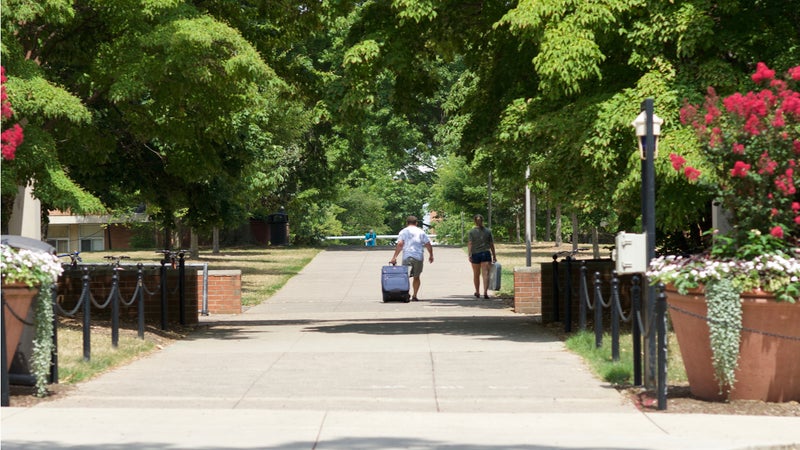How to pay for college

The Bankrate promise
At Bankrate we strive to help you make smarter financial decisions. While we adhere to strict , this post may contain references to products from our partners. Here's an explanation for .
The rising cost of higher education is an intimidating hurdle for many students. Between the 1992-1993 and 2022-2023 school years, the average cost of college tuition and fees more than doubled at public four-year institutions, according to the College Board — and that’s after accounting for inflation. If you’re a student looking to pursue a college degree, many creative options exist for easing the financial burden.
Use grants
Grants are a type of financial aid that does not need to be repaid, and often they are distributed to students with financial need. Grants typically cover several thousand dollars worth of college expenses, making them significant financial aid. A common example of a grant is the Pell Grant, which provides up to $7,395 for the 2023-24 academic year.
You must complete the Free Application for Federal Student Aid (FAFSA) to qualify for all federal and many state-based grants. Some states will also have their own separate applications for grants. Visit your state’s Department of Education website to see how to apply.
Apply for work-study
Work-study is a form of federal financial aid where you receive a job either at the school or with an affiliated organization. You are paid hourly and can use the funds to cover tuition, fees, living expenses or anything else you need. Work-study is awarded based on financial need.
Most students work between 10 and 15 hours a week and can often schedule work around their class schedule. Common jobs include working at the campus library, at the front desk of a dorm or the campus rec center. Federal work-study matches students with jobs that align with their major when possible.
You can be eligible for work-study by filling out the FAFSA. It’s best to do this as soon as possible because work-study jobs are limited and given on a first-come, first-served basis. If you procrastinate sending in the FASFA, you may not get a work-study position.
Apply for scholarships
Like grants, scholarships do not have to be repaid after graduation and are one of the best ways to pay for college. Start by applying to your school’s scholarships, then use scholarship search engines like Scholarships.com, Unigo and Fastweb to find more opportunities.
It’s best to apply for scholarships early, particularly because some scholarship programs limit the number of applications they will consider. If you delay applying, it’s possible that your application may not be accepted.
Start saving early
The golden rule of college finance still rings true: Start saving early to maximize compound interest. A college savings calculator shows that parents who start investing $200 per month when their child is born will have about $76,500 in that account by the time their child turns 18, assuming a 6 percent rate of return. However, parents who begin investing when their child is 10 will accumulate only $24,500 with the same rate of return.
“Time is your greatest asset,” says Mark Kantrowitz, a financial aid expert. “If you start saving from birth, about a third of your college savings goal will come from earnings. If you wait until your child enters high school, less than 10 percent will come from earnings, and you’ll have to save six times as much per month to reach the same college savings goal.”
Assess family finances
The federal financial aid formula considers assets such as stocks, mutual funds, certificates of deposit and rental properties that your family owns when calculating how much your parents can afford to pay for college. Other investment vehicles, like retirement plans, life insurance policies and home equity in your family’s primary residence, are not included in the federal financial aid formula.
Parents may qualify for more financial aid if they store assets in places not considered on the FAFSA. That includes paying off unsecured debt like personal loans and credit cards. Parents should talk to a tax expert or financial planner about moving these assets without incurring a large tax bill.
Get help from family
Parents and students don’t have to shoulder the burden of college costs alone. Grandparents and other family members can contribute to a student’s 529 plan, and there are built-in perks for those who give big.
The IRS allows individuals to give financial gifts of up to $17,000 per year per beneficiary to a 529 plan without disclosing the gift to the IRS. All 529 plans come with an additional caveat allowing donors to give a financial gift of up to five years of funds at a time, for $85,000, without incurring gift taxes.
If a family member considers this, have them speak with a tax professional to ensure it’s executed correctly.
Compare 529 plans
A 529 college savings plan allows you to set aside money for qualified educational expenses so it can grow tax-free and be withdrawn tax-free later on.
These 529 college savings plans can vary dramatically in fees, investment options, tax incentives and rates of return. While some states offer generous tax deductions and credits, others offer few or no state tax incentives. There are no federal tax benefits for 529 contributions.
When comparing different plans, research 529 plan ratings through organizations such as Morningstar, look into your home state’s 529 plans and figure out what state tax incentives you may be eligible for. You can invest in any state’s 529 plan, not just where you reside, but you may not get a tax break if you invest in a different state’s plan.
If your state doesn’t offer tax benefits and you can get more investment options and lower fees through another state’s plan, consider using that one instead of what your state offers.
Choose an affordable school
The cost of college and the amount of aid available varies immensely by institution. Certain schools offer full-tuition scholarships, while some “work colleges” offer free or reduced tuition in exchange for the student working at the university.
Even many pricey institutions offer significant discounts to low- and moderate-income students. Visit the National Center for Education Statistics’ College Navigator website to research average financial aid packages by income bracket.
Also compare the total cost of attendance for each school you’re considering. You can usually find this information on the school’s admissions page online.
Take out federal student loans
If you’ve exhausted all other options for getting money to pay for college, consider borrowing federal student loans.
Federal loans have relatively low interest rates, especially for undergraduate students. If you’re an undergrad with financial need, you may qualify for subsidized loans, where interest does not accrue in school or during deferment periods.
To apply for federal loans, you need to fill out the FAFSA. There’s no credit check for most federal loans, and you’ll get the same interest rate as all other borrowers. When you receive your financial aid award letter, you can decide how much you need to borrow.
Federal student loans are typically the first choice for students who need to borrow money for college since they come with benefits that private student loans can’t offer. For instance, they have extensive deferment and forbearance options, loan forgiveness programs and several income-driven repayment plans.
Apply for private student loans
Private student loans can be another way to cover the cost of college. However, they’re generally considered to be a last resort. Private loans typically require a credit check to get approved, which means it can be tough to qualify as a college student with little or no credit history. Even if you get approved, your interest rate is based on your creditworthiness, so your loans could be expensive.
With that said, most lenders allow co-signers, which can help you qualify and get a low interest rate. However, this also means that the loans will show up on the co-signer’s credit report, which could make it difficult for them to get approved for their loans.
If you’ve exhausted all your federal student loans, which are capped on an annual and aggregate basis, private student loans can be much better than higher-interest options like credit cards.
How to pay off student loans after college
If you have a federal student loan, you may be eligible for programs like Public Service Loan Forgiveness, which forgives your remaining student loan balance after 120 consecutive payments while working for a qualifying employer. You can also sign up for an income-driven repayment plan, which could decrease the monthly amount you have to pay. Depending on the plan, income-driven repayment plans also come with loan forgiveness after 20 or 25 years.
Borrowers with private loans might refinance their loans to get a lower interest rate or better repayment terms. You can also refinance your federal loans into a private loan if you spot a particularly good interest rate, though you’ll lose the benefits of the federal program.
The key is to create a plan for your student loans based on your goals and budget. With the right strategy, you could end up paying off your debt early, saving money on interest, and even getting some of it forgiven.
The bottom line
Paying for a college education is an investment, but resourceful students can source and combine multiple financing strategies. There are ways to minimize student loan debt, from applying for monetary awards to saving in advance to working while in school to offset costs. And when needed, public and private student loans– when borrowed with care– can help you to achieve your academic goals.




